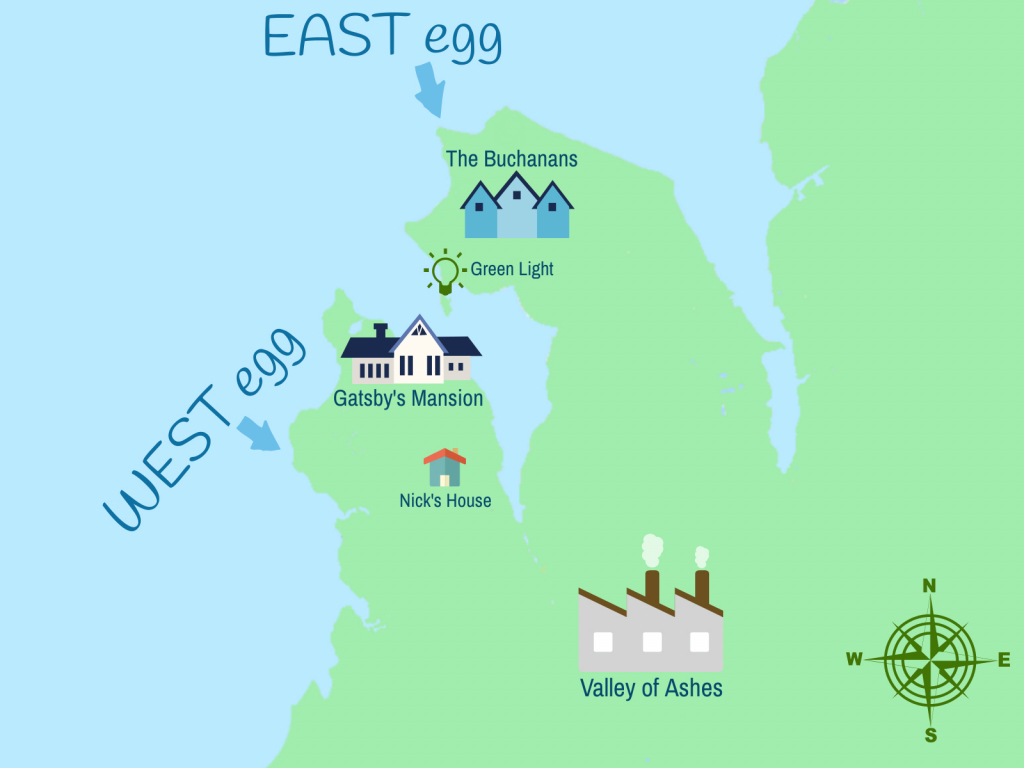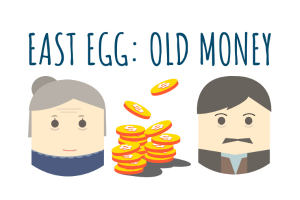The Great Gatsby takes place in New York City, East Egg, West Egg, and the Valley of Ashes. The so-called “nouveau riches” (or “new money”) live in West Egg, while the aristocratic families prefer East Egg. Between the Eggs and NYC on the fictional The Great Gatsby map lies the Valley of Ashes, a symbol of decay.
The location of Fitzgerald’s The Great Gatsby is important because it’s symbolically tied to the characters and the general message. The novel’s setting reflects the themes of social class, wealth, and the American Dream.
If you want to know more about the role of setting in The Great Gatsby, keep reading this informative article prepared by our editorial team. Below, you’ll find answers to questions such as:
- Where does The Great Gatsby take place?
- Who exactly lives in East Egg and West Egg?
- Where does Gatsby live, and what does the description of his house reveal about his character?
- Where does Nick live in The Great Gatsby?
In addition, we will present a map with key locations and discuss the meaning behind the setting of The Great Gatsby, highlighting every place separately.
🌍 The Great Gatsby Setting Map
Below you’ll find The Great Gatsby setting map with all the key locations mentioned in the novel.

📍 Why Is the Location of Fitzgerald’s The Great Gatsby Important?
One of the most critical questions in The Great Gatsby‘s analysis is, “How does Fitzgerald use setting?” The location of Fitzgerald’s The Great Gatsby is important because it highlights the decadence of the 1920s. The Roaring Twenties was a period of economic prosperity, cultural dynamism, and general optimism. Everything looked new and exciting. However, many aspects of the US economy at the time did lead to the Great Depression.
🥚 West Egg & East Egg in The Great Gatsby
It seems like the location of Fitzgerald’s The Great Gatsby is important because it highlights the indulgence of the luxury that occurred in the Roaring Twenties. It is related to both West and East Egg.
West Egg and East Egg in The Great Gatsby appear as twin brothers that look similar but have such a drastic difference in the characters. The only thing is sure. This area is not a place for poor people. The richest of the richest build their massive mansions there.
They are not perfect ovals – like the egg in the Columbus story they are both crushed flat at the contact end – but their physical resemblance must be a source of perpetual confusion to the gulls that fly overhead. To the wingless a more arresting phenomenon is their dissimilarity in every particular except shape and size.
The Great Gatsby, Nick Carraway, Chapter 1
Let’s analyze the houses of the main characters of the story.
East Egg in The Great Gatsby

Even though the names are made, East Egg and West Egg exist in real life. Fitzgerald lived on Long Island with his wife. The multiple peninsulas and villages of that place served as an inspiration for the book.
Long Island’s East Egg is a home for so-called “old money.” Like any place where people with big money would live, this area is exceptionally luxurious and almost exclusive. It is where Tom and Daisy Buchanan live.
East Egg, in New York, is located outside the big city and faces the neighboring area, West Egg. This place is also famous for the rich people residing here. However, they are not just any rich people. They come from the old aristocratic families that have been having their fortunes for quite a long time.
This side of the bay is also a favorite place for famous and VIP people. However, it seems like Nick Carraway is an exception. Despite his background, he prefers to settle down in West Egg, which we discuss later on.
Indeed, the taste of aristocrats is widely known. Therefore, their homes look not only expensive but also elegant. Nick says how “the white palaces of fashionable East Egg glittered along the water…”
The East Egg residents also try never to miss a chance to mock their neighbors from West Egg. Sometimes they comment on their behavior, but they drop some comments on the housing as well:
…East Egg condescending to West Egg, and carefully on guard against its spectroscopic gayety.
The Great Gatsby, Nick Carraway, Chapter 3
Tom Buchanan’s House
Tom Buchanan’s house is truly a palace. It means that their family knows how to waste their fortune with luxury. Gardens, French windows, and gold are some of the features that Nick notices when he comes to visit them.
The interior is made in pink, red, and white colors. Altogether, it adds some elegance and charm to the place. Everything indicates a good taste of the owners. The first impression of Daisy creates almost the same feelings as the mansion.
However, Nick points out that the curtains thrown around by the wind create some feeling of tension at Buchanan’s nest.
West Egg in The Great Gatsby

The Great Gatsby’s West Egg is also based on a real-life place. The Eggs are not only separated by the bay but also by the Valley of Ashes. So everyone going from the peninsulas to New York City has to pass through it.
Following the theme of money, it also appears to be a base for the richest people to settle down. However, there is one important detail. All the rich living in New York’s West Egg are so-called “new money.” They are not coming from aristocratic families. Instead, new money earned their fortunes during the last years of the 1920s.
West Egg inhabitants can’t live across the bay, in East Egg, because they don’t have enough connection yet. It even seems like they are the outcasts. The high society of aristocratic families can’t allow new money to live next door.
It is quite clear from the impression of the Buchanans during the visit to Gatsby’s house. They are not happy to be there. They even look like the only fact of them being in such a place lowers their value as VIP.
It is where Gatsby’s and Nick’s houses are located. Nick appears to be an exception from the rule. He comes from a wealthy old family and could easily afford to move to East Egg. However, as it can be judged from his character’s analysis, he has some values and a specific perspective.
Despite the differences between the inhabitants of the two Eggs, they share one interesting feature. Unlike the external characteristics, this difference concerns values and sense of life. Both locations reek of desperation and emptiness.
Despite having everything they wish, all those rich people can’t seem to find the point of their lives. It is described in detail in the analysis of the chapters. There are quite a few scenes that show it.
Gatsby’s Mansion
Unlike the Buchanans, Gatsby does live in West Egg. He moved there as soon as he earned enough money to get a huge mansion. Gatsby is an example of new money. His enormous fortune didn’t appear from the air. It all comes from illegal alcohol production and distribution. That is why Tom fairly accuses him of being a bootlegger.
Gatsby’s mansion is posh and lavish. However, according to Nick, it is rather tasteless. Just like any other representative of the new money class, Gatsby wants to show off. The real reason behind it is the desire to attract Daisy’s attention.
Nick says that Gatsby’s house looks like a vulgar copy of a hotel in Paris. It is exactly the reason why people from East Egger think West Eggers are not sophisticated enough. It also points out that the owner himself is a tasteless parody. Gatsby tries to be someone else while chasing his dream.
Nick Carraway’s House
The question “Where does Nick Carraway live?” shouldn’t be a question anymore, since we have mentioned it so many times so far. Nick lives in West Egg. He moved there when he decided to try a new career in New York. However, the dramatic life there becomes overwhelming for Carraway, and he moves back home the same year.
Nick Carraway’s house seems almost tiny in comparison to the neighbors’ gigantic mansions. Nevertheless, we already know that he is not poor. It appears to be just his personal choice.
He talks about his home as being “squeezed between two huge places.” It is a metaphor for his emotional state. He is pushed to become a mediator for all the relationship drama between Buchanans and Gatsby.
🦇 The Valley of Ashes in The Great Gatsby
The Valley of Ashes is a place caught between the Eggs and New York City, where the Wilsons live. It got this name because all the industries there produce so much ash that it covers everything. Even the people living there look gray. The Great Gatsby’s Valley of Ashes carries a symbolic meaning behind it, which we analyze below.
Valley of Ashes: Symbolism
All the phrases Nick uses to describe this place come down to one picture: lifeless people who live a life full of all shades of gray. Unwillingly, you might start thinking about death, and you would be right.
This is a valley of ashes – a fantastic farm where ashes grow like wheat into ridges and hills and grotesque gardens where ashes take the forms of houses and chimneys and rising smoke and finally, with a transcendent effort, of men who move dimly and already crumbling through the powdery air.
The Great Gatsby, Nick Carraway, Chapter 2
Those who live in the valley are destined to be born, work, and die there. Even the most energetic and hopeful characters, like Myrtle, are doomed to fail. It seems like even the eyes from the billboard, as one of the novel’s main symbols, are not there to help. They are there to watch people slowly die.
What Does the Valley of Ashes Symbolize?
Those who live in the valley are destined to be born, work, and die there. Even the most energetic and hopeful characters, like Myrtle, are doomed to fail. It seems like even the eyes from the billboard, as one of the novel’s main symbols, are not there to help. They are there to watch people slowly die.
What Does the Valley of Ashes Symbolize?
The Valley of Ashes symbolizes the despair of people living in poverty. Low-income families like the Wilsons are constantly being mocked and humiliated by the rich. They are hopeless, and it seems like nothing can be done to improve their position. The ashes always stay in the valley, no matter how well people clean it.
As an example, the Wilson family appears to be the key part of the chain of events. George Wilson is the owner of a garage in the valley. His whole body and attitude show that he has lost hope, though he is still trying to change.
Another essential role of this setting is that it emphasizes the gap between the classes. The scene when Tom Buchanan comes to Wilson is one of the best examples. The way how Tom treats Wilson represents the displease he feels towards the poor.
Moreover, Nick says that the valley looks “vaguely disquieting.” It implies the lack of moral values during that period.
We can’t miss the significance of another metaphor. The Valley of Ashes might represent a sort of warning for the rich. Their careless festivities must come to an end one day. It is a symbol of the unpreventable collapse of the Roaring Twenties kingdom.
